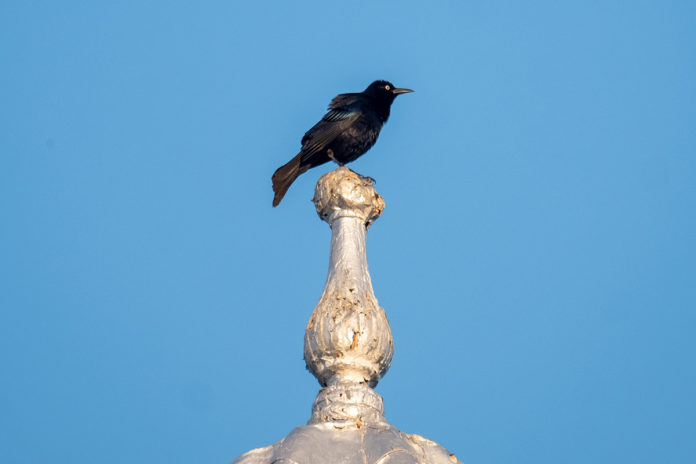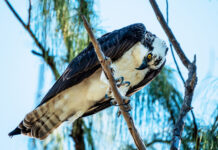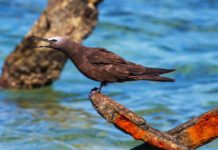
I’d say I can’t tell you the last time I saw a common grackle, but that wouldn’t be true. I saw one last Saturday while riding my bike down Seidenberg Avenue.
But I honestly can’t tell you the last time I’d seen one before that. September, maybe? October?
It’s always difficult to notice when a bird leaves the landscape. They don’t say anything; they don’t even give you the nod. They step off a branch and head toward the horizon sans fanfare. All this stuff about whether it should be called a French Exit or an Irish Goodbye? Feh. Birds have been leaving the party without a farewell since before we had written language. It should be the Avian Arrivederci.
It’s easier to notice when birds re-appear, though, much as when new people arrive at a party. We get two kinds of grackles in Key West – boat-tailed grackles and common grackles.
The males of the two species are largish, unadorned, nearly black songbirds with longish bills and longish tails. The boat-tails are actually bigger and have a slightly longer tail, but the distinction is difficult to parse in the field. Female common grackles also look pretty much the same. The female boat-tails, though, are tobacco brown and therefore stick out.
As grackles tend to travel in small flocks, if you see some brown ones mixed in with the blackish ones, you know they’re boat-tails. If you don’t, they are most likely common grackles.
But you don’t have to worry much about such ID problems in Key West. We only have a small posse of about 20 of boat-tailed grackles here. I used to see them down by the ferry terminal, but now I see them more often around the Wendy’s in Searstown. (If you want to see a lot of boat-tails, get out of your car in any fast-food or gas station parking lot in Florida City.)
Common grackles, though? They’ll be all over your neighborhood in a couple weeks, dozens of them, making a ruckus, foraging for food and giving a loud, un-melodic call that always sounds to me like a squeaky swing set.
The birds we see here are members of a subspecies whose range stretches north to North Carolina and west to Louisiana. Back in the day they were considered their own species, the Florida grackle, and it’s fun to call them that sometimes, if only to convince other birders you’re using a really out-of-date field guide.
The interesting thing about Florida grackles, though, is they don’t really migrate, or at least the vast majority don’t. The only ones that really do are the ones in the Keys, disappearing as they do in September and October (I think) and reappearing in early March every year.
Why do our common grackles migrate? Where do they go? It would take a small team of biologists, a modest budget and some satellite trackers to figure it all out. Most likely they just go up to the mainland. (Common grackles are seen year round in Homestead.) As most birds migrate to have access to a steady supply of food, it’s possible something here disappears from their diet.
But also, nobody really worries about it because, well, they’re grackles. For some reason they don’t get a lot of love, even in the bird world.
Part of it may be their ubiquity and their success. Common grackles are one of the species that has thrived with human development, their population growing as forests in North America were replaced with farmland and suburbs, booming so much so that they are now considered an agricultural pest in many places.
Part of it may be their unspectacularness and the fact that they look like smaller, less-handsome crows. Which may not be fair, because if you really look at them, they are not so much a dull blackish as a deep iridescent purple, with a yellow pinpoint of an eye that’s really quite something.
Their reputation is low enough to have made them a punchline on an episode of “Brooklyn 99,” with characters repeatedly using the insult, “You grackle,” which worked very well in Andre Braugher’s gravitas-laden baritone. (It was the second funniest bird-related joke in the episode, after, “Apparently he’s very into birdwatching, so talking to a woman should blow his mind.”)
Trash-talking common grackles seems to be a long-standing tradition. I was reading about them in the weighty tome “Birds of America,” published in 1917 and updated in 1936. It started well, with the author stating that the grackle “presents a fine appearance as he walks, indeed, struts, about on the deepening green of lawns.” But then they write, “A mistake which this grackle makes is in trying to sing.”
They then pile on with accusations of cannibalism and nest-robbing, and talking about how all the robins, bluebirds, thrushes and sparrows hate them, and adding, “when the birds unite in giving one of their number a bad name, we may be tolerably certain that he deserves it.” Which seems a bit much. Eating a member of a different species is not cannibalism, and the egg predation is totally overblown. (It’s, like, 1 percent of their diet.)
All this has started to make me think of common grackles as underdogs, and I’m going to try and start fresh with them this year, show a little more interest, take a kinder look at what they’re up to, maybe hire them a publicist.

























